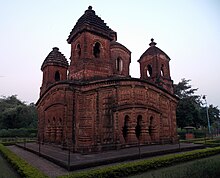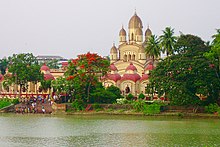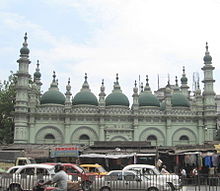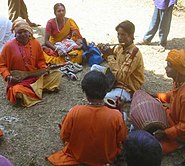West Bengal
Cities
The capital and largest city of the state is Kolkata—the third-largest urban agglomeration[117] and the seventh-largest city[118] in India. Asansol is the second-largest city and urban agglomeration in West Bengal.[117]
Major planned cities of West Bengal include Bidhannagar, New Town, Kalyani, Haldia, Durgapur and Kharagpur. Kolkata has some planned neighbourhoods like New Garia, Tollygunge, and Lake Town. Siliguri is an economically important city, strategically located in the northeastern Siliguri Corridor (Chicken's Neck) of India.[119] Other larger cities and towns in West Bengal are Howrah, Chandannagar, Bardhaman, Baharampur, Jalpaiguri, and Purulia etc.[120]
Economy
Main article: Economy of West Bengal
Net State Domestic Product at Factor Cost at Current Prices (2004–05 Base)[121]
(figures in crores of Indian rupees)
YearNet State Domestic Product2004–2005190,0732005–2006209,6422006–2007238,6252007–2008272,1662008–2009309,7992009–2010366,318 The Grand Hotel in Kolkata. Tourism, especially from Bangladesh, is an important part of West Bengal's economy.
The Grand Hotel in Kolkata. Tourism, especially from Bangladesh, is an important part of West Bengal's economy.
As of 2015, West Bengal has the sixth-highest GSDP in India. GSDP at current prices (base 2004–2005) has increased from Rs 2,086.56 billion in 2004–05 to Rs 8,00,868 crores in 2014–2015,[122] reaching Rs 10,21,000 crores in 2017–18.[123] GSDP per cent growth at current prices varied from a low of 10.3% in 2010–2011 to a high of 17.11% in 2013–2014. The growth rate was 13.35% in 2014–2015.[124] The state's per capita income has lagged the all India average for over two decades. As of 2014–2015, per capita NSDP at current prices was Rs 78,903.[124] Per-capita NSDP growth rate at current prices varied from 9.4% in 2010–2011 to a high of 16.15% in 2013–2014. The growth rate was 12.62% in 2014–2015.[125]
In 2015–2016, the percentage share of Gross Value Added (GVA) at factor cost by economic activity at the constant price (the base year 2011–2012) was Agriculture-Forestry and Fishery—4.84%, Industry 18.51% and Services 66.65%. It has been observed that there has been a slow but steady decline in the percentage share of industry and agriculture over the years.[126] Agriculture is the leading economic sector in West Bengal. Rice is the state's principal food crop. Rice, potato, jute, sugarcane and wheat are the state's top five crops.[127]: 14 Tea is produced commercially in northern districts; the region is well known for Darjeeling and other high-quality teas.[127]: 14 State industries are localised in the Kolkata region, the mineral-rich western highlands, and the Haldia Port region.[128] The Durgapur-Asansol colliery belt is home to a number of steel plants.[128] Important manufacturing industries include: engineering products, electronics, electrical equipment, cables, steel, leather, textiles, jewellery, frigates, automobiles, railway coaches and wagons. The Durgapur centre has established several industries in the areas of tea, sugar, chemicals and fertilisers. Natural resources like tea and jute in nearby areas have made West Bengal a major centre for the jute and tea industries.[129]
Years after independence, West Bengal is dependent on the central government for help in meeting its demands for food; food production remained stagnant, and the Indian green revolution bypassed the state. However, there has been a significant increase in food production since the 1980s and the state now has a surplus of grains.[130] The state's share of total industrial output in India was 9.8% in 1980–1981, declining to 5% by 1997–1998. In contrast, the service sector has grown at a rate higher than the national rate.[130] The state's total financial debt stood at ₹1,918,350 million (US$24 billion) as of 2011.[131]
In the period 2004–2010, the average gross state domestic product (GSDP) growth rate was 13.9% (calculated in Indian rupee terms) lower than 15.5%, the average for all states of the country.[127]: 4
The economy of West Bengal has witnessed many surprising changes in direction. The agricultural sector in particular rose to 8.33% in 2010–11 before tumbling to −4.01% in 2012–13.[132] Many major industries such as the Uttarpara Hindustan Motors car manufacturing unit, the jute industry, and the Haldia Petrochemicals unit experienced shutdowns in 2014. In the same year, plans for a 300 billion Jindal Steel project was mothballed. The tea industry of West Bengal has also witnessed shutdowns for financial and political reasons.[133] The tourism industry of West Bengal was negatively impacted in 2017 because of the Gorkhaland agitation.[134]
However, over the years due to effective changes in the stance towards industrialisation, ease of doing business has improved in West Bengal.[135][136][137] Steps are being taken to remedy this situation by promoting West Bengal as an investment destination. A leather complex has been built in Kolkata. Smart cities are being planned close to Kolkata, and major roadway projects are in the offing to revive the economy.[138] West Bengal has been able to attract 2% of the foreign direct investment in the last decade.[139]
Transport
See also: Transport in West Bengal and List of airports in West Bengal

- Netaji Subhash Chandra Bose International Airport is a hub for flights to and from Bangladesh, East Asia, Nepal, Bhutan and north-east India.
-

- Durgapur Expressway
-

- An SBSTC bus in Karunamoyee
-

- Kolkata Metro, India's first metro rail system
As of 2011, the total length of surface roads in West Bengal was over 92,023 kilometres (57,180 miles);[127]: 18 national highways comprise 2,578 km (1,602 mi)[140] and state highways 2,393 km (1,487 mi).[127]: 18 As of 2006, the road density of the state was 103.69 kilometres per square kilometre (166.87 miles per square mile), higher than the national average of 74.7 km/km2 (120.2 mi/sq mi).[141]
As of 2011, the total railway route length was around 4,481 km (2,784 mi).[127]: 20 Kolkata is the headquarters of three zones of the Indian Railways—Eastern Railway and South Eastern Railway and the Kolkata Metro, which is the newly formed 17th zone of the Indian Railways.[142][143] The Northeast Frontier Railway (NFR) serves the northern parts of the state. The Kolkata metro is the country's first underground railway.[144] The Darjeeling Himalayan Railway, part of NFR, is a UNESCO World Heritage Site.[145]
Netaji Subhas Chandra Bose International Airport at Dum Dum, Kolkata, is the state's largest airport. Bagdogra Airport near Siliguri is a customs airport that offers international service to Bhutan and Thailand, besides regular domestic service. Kazi Nazrul Islam Airport, India's first private sector airport, serves the twin cities of Asansol-Durgapur at Andal, Paschim Bardhaman.[146][147]
Kolkata is a major river port in eastern India. The Kolkata Port Trust manages the Kolkata and the Haldia docks.[148] There is passenger service to Port Blair on the Andaman and Nicobar Islands. Cargo ship service operates to ports in India and abroad, operated by the Shipping Corporation of India. Ferries are a principal mode of transport in the southern part of the state, especially in the Sundarbans area. Kolkata is the only city in India to have trams as a mode of transport; these are operated by the Calcutta Tramways Company.[149]
Several government-owned organisations operate bus services in the state, including: the Calcutta State Transport Corporation, the North Bengal State Transport Corporation, the South Bengal State Transport Corporation, the West Bengal Surface Transport Corporation and the Calcutta Tramways Company.[150] There are also private bus companies. The railway system is a nationalised service without any private investment.[151] Hired forms of transport include metered taxis and auto rickshaws, which often ply specific routes in cities. In most of the state, cycle rickshaws and in Kolkata, hand-pulled rickshaws and electric rickshaws are used for short-distance travel.[152]
Demographics
Historical populationYearPop.±%190116,940,088— 191117,998,769+6.2%192117,474,348−2.9%193118,897,036+8.1%194123,229,552+22.9%195126,300,000+13.2%196134,926,000+32.8%197144,312,000+26.9%198154,581,000+23.2%199168,078,000+24.7%200180,176,000+17.8%201191,276,115+13.8%202298,604,000+8.0%Source: Census of India[153]
According to the provisional results of the 2011 national census, West Bengal is the fourth-most-populous state in India with a population of 91,347,736 (7.55% of India's population).[3] The state's 2001–2011 decennial population growth rate was 13.93%,[3] lower than the 1991–2001 growth rate of 17.8%[3] and lower than the national rate of 17.64%.[154] The gender ratio is 947 females per 1,000 males.[154] As of 2011, West Bengal had a population density of 1,029 inhabitants per square kilometre (2,670/sq mi) making it the second-most densely populated state in India, after Bihar.[154]
The literacy rate is 77.08%, higher than the national rate of 74.04%.[155] Data from 2010 to 2014 showed the life expectancy in the state was 70.2 years, higher than the national value of 67.9.[156][157] The proportion of people living below the poverty line in 2013 was 19.98%, a decline from 31.8% a decade ago.[158] Scheduled castes and tribes form 28.6% and 5.8% of the population, respectively, in rural areas and 19.9% and 1.5%, respectively, in urban areas.[130]
In September 2017, West Bengal achieved 100% electrification, after some remote villages in the Sunderbans became the last to be electrified.[159]
As of September 2017, of 125 towns and cities in Bengal, 76 have achieved open defecation free (ODF) status. All towns in the districts of: Nadia, North 24 Parganas, Hooghly, Bardhaman and East Medinipur are ODF zones, with Nadia becoming the first ODF district in the state in April 2015.[160][161]
A study conducted in three districts of West Bengal found that accessing private health services to treat illness had a catastrophic impact on households. This indicates the importance of the public provision of health services to mitigate poverty and the impact of illness on poor households.[162]
The latest Sample Registration System (SRS) statistical report shows that West Bengal has the lowest fertility rate among Indian states. West Bengal's total fertility rate was 1.6, lower than neighbouring Bihar's 3.4, which is the highest in the entire country. Bengal's TFR of 1.6 roughly equals that of Canada.[163]
Bengalis, consisting of Bengali Hindus, Bengali Muslims, Bengali Christians and a few Bengali Buddhists, comprise the majority of the population.[164] Marwari, Maithili and Bhojpuri speakers are scattered throughout the state; various indigenous ethnic Buddhist communities such as the Sherpas, Bhutias, Lepchas, Tamangs, Yolmos and ethnic Tibetans can be found in the Darjeeling Himalayan hill region. Native Khortha speakers are found in Malda district.[165]
Surjapuri, a language considered to be a mix of Maithili and Bengali, is spoken across northern parts of the state.[166] The Darjeeling Hills are mainly inhabited by various Gorkha communities who overwhelmingly speak Nepali (also known as Gorkhali), although there are some who retain their ancestral languages like Lepcha. West Bengal is also home to indigenous tribal Adivasis such as: Santhal, Munda, Oraon, Bhumij, Lodha, Kol and Toto.
There are a small number of ethnic minorities primarily in the state capital, including : Chinese, Tamils, Maharashtrians, Odias, Malayalis, Gujaratis, Anglo-Indians, Armenians, Jews, Punjabis and Parsis.[167] India's sole Chinatown is in eastern Kolkata.[168]
Languages
Languages of West Bengal (2011)[169]
Bengali (86.22%)
Hindi (6.97%)
Santali (2.66%)
Urdu (1.82%)
Nepali (1.27%)
Others (1.06%)
The state's official languages are Bengali and English;[4] Nepali has additional official status in the three subdivisions of Darjeeling district.[4] In 2012, the state government passed a bill granting additional official status to Hindi, Odia, Punjabi, Santali and Urdu in areas where speakers exceed 10% of the population.[4] In 2019, another bill was passed by the government to include Kamtapuri, Kurmali and Rajbanshi as additional official languages in blocks, divisions or districts where the speakers exceed 10% of the population.[4] On 24 December 2020, Chief Minister Mamata Banerjee announced Telugu as an additional official language.[4] As of the 2011 census, 86.22% of the population spoke Bengali, 5.00% Hindi, 2.66% Santali, 1.82% Urdu and 1.26% Nepali as their first language.[169]
Religion
Main article: Religion in West Bengal
Religion in West Bengal (2011)[170]
Hinduism (70.54%)
Islam (27.01%)
Christianity (0.72%)
Buddhism (0.31%)
No religion (0.25%)
Jainism (0.07%)
Sikhism (0.07%)
Other Religions (inc. Tribal religions, Judaism and Zoroastrianism) (1.03%)
West Bengal is religiously diverse, with regional cultural and religious specificities. Although Hindus are the predominant community, the state has a large minority Muslim population. Christians, Buddhists and others form a minuscule part of the population. As of 2011, Hinduism is the most common religion, with adherents representing 70.54% of the total population.[171] Muslims, the second-largest community, comprise 27.01% of the total population,[172] Three of West Bengal's districts: Murshidabad, Malda and Uttar Dinajpur, are Muslim-majority. Sikhism, Christianity, Buddhism and other religions make up the remainder.[173] Buddhism remains a prominent religion in the Himalayan region of the Darjeeling hills; almost the entirety of West Bengal's Buddhist population is from this region.[174] Christianity is mainly found among the tea garden tribes at tea plantations scattered throughout the Dooars of Darjeeling, Jalpaiguri and Alipurduar districts.
The Hindu population of West Bengal is 64,385,546 while the Muslim population is 24,654,825, according to the 2011 census.[175]
Culture
See also: Bengalis, Culture of West Bengal, and Culture of Darjeeling
Literature
Main articles: Bengali literature and History of Bengali literature
Rabindranath Tagore is Asia's first Nobel laureate and the composer of India's national anthem.
Swami Vivekananda was a key figure in introducing Vedanta and Yoga to Europe and the US,[176] raising interfaith awareness and making Hinduism a world religion.[177]
The Bengali language boasts a rich literary heritage it shares with neighbouring Bangladesh. West Bengal has a long tradition of folk literature, evidenced by the Charyapada, a collection of Buddhist mystic songs dating back to the 10th and 11th centuries; Mangalkavya, a collection of Hindu narrative poetry composed around the 13th century; Shreekrishna Kirtana, a pastoral Vaishnava drama in verse composed by Boru Chandidas; Thakurmar Jhuli, a collection of Bengali folk and fairy tales compiled by Dakshinaranjan Mitra Majumder; and stories of Gopal Bhar, a court jester in medieval Bengal. In the 19th and 20th centuries, Bengali literature was modernised in the works of authors such as Bankim Chandra Chattopadhyay, whose works marked a departure from the traditional verse-oriented writings prevalent in that period;[178] Michael Madhusudan Dutt, a pioneer in Bengali drama who introduced the use of blank verse;[179] and Rabindranath Tagore, who reshaped Bengali literature and music. Indian art saw the introduction of Contextual Modernism in the late 19th and early 20th centuries.[180] Other notable figures include Kazi Nazrul Islam, whose compositions form the avant-garde genre of Nazrul Sangeet,[181] Sarat Chandra Chattopadhyay, whose works on contemporary social practices in Bengal are widely acclaimed,[182] and Manik Bandyopadhyay, who is considered one of the leading lights of modern Bengali fiction.[183] In modern times, Jibanananda Das has been acknowledged as "the premier poet of the post-Tagore era in India".[184] Other writers include: Bibhutibhushan Bandopadhyay, best known for his work Pather Panchali; Tarashankar Bandopadhyay, well known for his portrayal of the lower strata of society;[185] Manik Bandopadhyay, a pioneering novelist; and Ashapurna Devi, Shirshendu Mukhopadhyay, Saradindu Bandopadhyay, Buddhadeb Guha, Mahashweta Devi, Samaresh Majumdar, Sanjeev Chattopadhyay, Shakti Chattopadhyay, Buddhadeb Basu,[186] Joy Goswami and Sunil Gangopadhyay.[187][188]
Music and dance
Main article: Music of West Bengal
Baul singers at Basanta-Utsab, Shantiniketan
Dance with Rabindra Sangeet

A notable music tradition is the Baul music, practised by the Bauls, a sect of mystic minstrels.[189] Other folk music forms include Gombhira and Bhawaiya. Folk music in West Bengal is often accompanied by the ektara, a one-stringed instrument. Shyama Sangeet is a genre of devotional songs, praising the Hindu goddess Kali; kirtan is devotional group songs dedicated to the god Krishna.[190] Like other states in northern India, West Bengal also has a heritage in North Indian classical music. Rabindrasangeet, songs composed and set to words by Rabindranath Tagore, and Nazrul geeti (by Kazi Nazrul Islam) are popular. Also prominent are Dwijendralal, Atulprasad and Rajanikanta's songs, and adhunik or modern music from films and other composers.[191] From the early 1990s, new genres of music have emerged, including what has been called Bengali Jeebonmukhi Gaan (a modern genre based on realism). Bengali dance forms draw from folk traditions, especially those of the tribal groups, as well as the broader Indian dance traditions. Chhau dance of Purulia is a rare form of masked dance.[192]
Films
Main article: Cinema of West Bengal Satyajit Ray, a pioneer in Bengali cinema along with Ravi Sankar.
Satyajit Ray, a pioneer in Bengali cinema along with Ravi Sankar.
West Bengali films are shot mostly in studios in the Kolkata neighbourhood of Tollygunge; the name "Tollywood" (similar to Hollywood and Bollywood) is derived from that name. The Bengali film industry is well known for its art films, and has produced acclaimed directors like Satyajit Ray who is widely regarded as one of the greatest filmmakers of the 20th century,[193] Mrinal Sen whose films were known for their artistic depiction of social reality, Tapan Sinha,[194] and Ritwik Ghatak. Some contemporary directors include veterans such as: Buddhadeb Dasgupta, Tarun Majumdar, Goutam Ghose, Aparna Sen, and Rituparno Ghosh, and a newer pool of directors such as Kaushik Ganguly and Srijit Mukherji.[195][196][197] Uttam Kumar was the most popular lead actor for decades, and his romantic pairing with actress Suchitra Sen in films attained legendary status.[198] Soumitra Chatterjee, who acted in many Satyajit Ray-films, and Prosenjit Chatterjee are among other popular lead male actors. As of 2020, Bengali films have won India's annual National Film Award for Best Feature Film twenty-two times in sixty seven years, the highest among all Indian languages.
Fine arts
 Panchchura Temple in Bishnupur, one of the older examples of the terracotta arts of India.
Panchchura Temple in Bishnupur, one of the older examples of the terracotta arts of India.
There are significant examples of fine arts in Bengal from earlier times, including the terracotta art of Hindu temples and the Kalighat paintings. Bengal has been in the vanguard of modernism in fine arts. Abanindranath Tagore, called the father of modern Indian art, started the Bengal School of Art, one of whose goals was to promote the development of styles of art outside the European realist tradition that had been taught in art colleges under the British colonial administration. The movement had many adherents, including: Gaganendranath Tagore, Ramkinkar Baij, Jamini Roy and Rabindranath Tagore. After Indian Independence, important groups such as the Calcutta Group and the Society of Contemporary Artists were formed in Bengal and came to dominate the art scene in India.[199][200]
Reformist heritage
The capital, Kolkata, was the workplace of several social reformers, including Raja Ram Mohan Roy, Iswar Chandra Vidyasagar and Swami Vivekananda. Their social reforms eventually led to a cultural atmosphere that made it possible for practices like sati, dowry, and caste-based discrimination, or untouchability, to be abolished.[201] The region was also home to several religious teachers, such as Chaitanya, Ramakrishna, Prabhupada and Paramahansa Yogananda.[201]
































